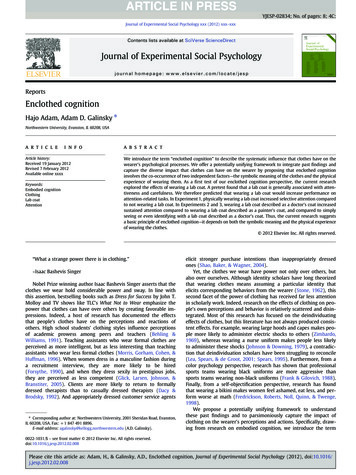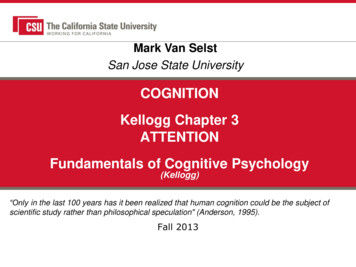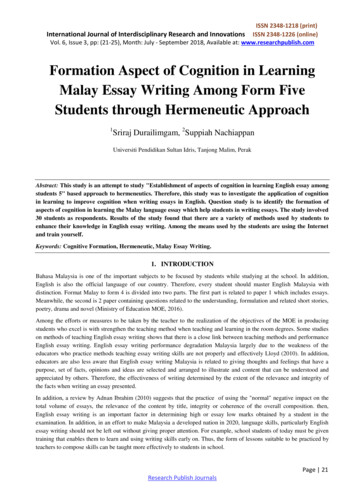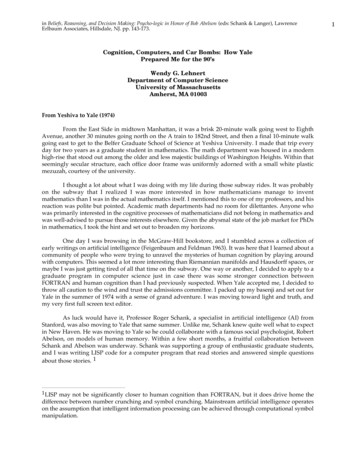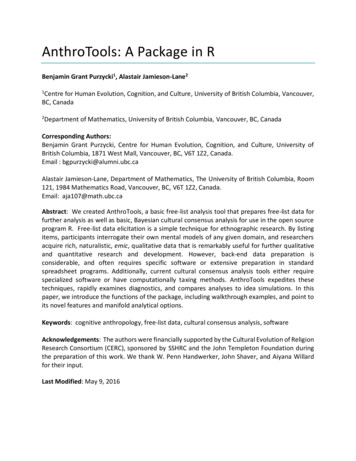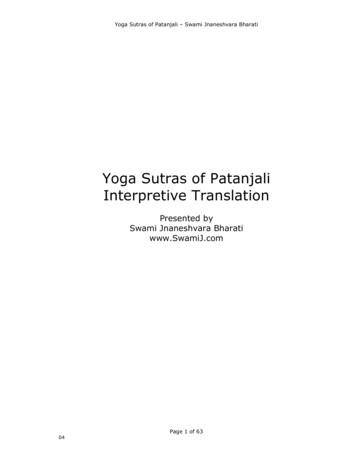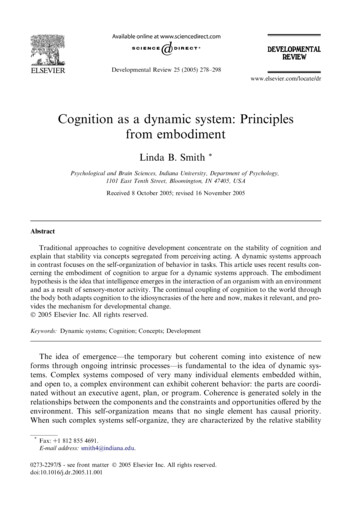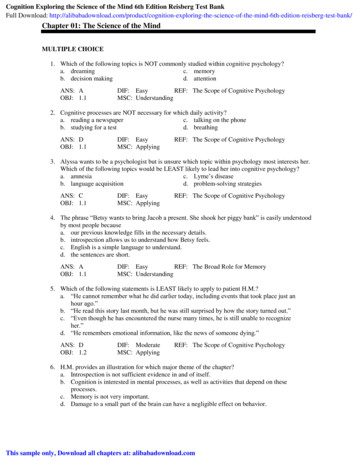
Transcription
Cognition Exploring the Science of the Mind 6th Edition Reisberg Test BankFull Download: test-bank/Chapter 01: The Science of the MindMULTIPLE CHOICE1. Which of the following topics is NOT commonly studied within cognitive psychology?a. dreamingc. memoryb. decision makingd. attentionANS: AOBJ: 1.1DIF: EasyREF: The Scope of Cognitive PsychologyMSC: Understanding2. Cognitive processes are NOT necessary for which daily activity?a. reading a newspaperc. talking on the phoneb. studying for a testd. breathingANS: DOBJ: 1.1DIF: EasyMSC: ApplyingREF: The Scope of Cognitive Psychology3. Alyssa wants to be a psychologist but is unsure which topic within psychology most interests her.Which of the following topics would be LEAST likely to lead her into cognitive psychology?a. amnesiac. Lyme’s diseaseb. language acquisitiond. problem-solving strategiesANS: COBJ: 1.1DIF: EasyMSC: ApplyingREF: The Scope of Cognitive Psychology4. The phrase “Betsy wants to bring Jacob a present. She shook her piggy bank” is easily understoodby most people becausea. our previous knowledge fills in the necessary details.b. introspection allows us to understand how Betsy feels.c. English is a simple language to understand.d. the sentences are short.ANS: AOBJ: 1.1DIF: EasyREF: The Broad Role for MemoryMSC: Understanding5. Which of the following statements is LEAST likely to apply to patient H.M.?a. “He cannot remember what he did earlier today, including events that took place just anhour ago.”b. “He read this story last month, but he was still surprised by how the story turned out.”c. “Even though he has encountered the nurse many times, he is still unable to recognizeher.”d. “He remembers emotional information, like the news of someone dying.”ANS: DOBJ: 1.2DIF: ModerateMSC: ApplyingREF: The Scope of Cognitive Psychology6. H.M. provides an illustration for which major theme of the chapter?a. Introspection is not sufficient evidence in and of itself.b. Cognition is interested in mental processes, as well as activities that depend on theseprocesses.c. Memory is not very important.d. Damage to a small part of the brain can have a negligible effect on behavior.This sample only, Download all chapters at: alibabadownload.com
ANS: BOBJ: 1.2DIF: ModerateMSC: EvaluatingREF: The Scope of Cognitive Psychology7. Patients suffering from clinical amnesia are characterized by a disorder in theira. memory.b. ability to recognize patterns.c. speech.d. ability to comprehend language.ANS: AOBJ: 1.2DIF: EasyREF: Amnesia and Memory LossMSC: Remembering8. The phrase “fool me once, shame on you; fool me twice, shame on me” would not apply to H.M.Why?a. H.M. was never fooled.b. H.M. was incapable of learning.c. H.M. was able to learn certain things, like if someone was lying to him.d. H.M. values practical jokes.ANS: BOBJ: 1.2DIF: DifficultMSC: EvaluatingREF: Amnesia and Memory Loss9. The term “introspection” refers to thea. process by which one individual seeks to infer the thoughts of another individual.b. procedure of examining thought processing by monitoring the brain’s electrical activity.c. process of each person looking within, to observe his or her own thoughts and ideas.d. technique of studying thought by interpreting the symbols used in communication.ANS: COBJ: 1.3DIF: EasyREF: The Limits of IntrospectionMSC: Remembering10. A participant is asked to look within himself or herself and report on his or her own mentalprocesses. This method is calleda. self-evaluation.c. introspection.b. self-monitoring.d. mentalistic study.ANS: COBJ: 1.3DIF: EasyREF: The Limits of IntrospectionMSC: Remembering11. Introspection CANNOT be used to studya. topics that are strongly colored by emotion.b. mental events that are unconscious.c. processes that involve conceptual knowledge.d. events that take a long time to unfold.ANS: BOBJ: 1.3DIF: ModerateREF: The Limits of IntrospectionMSC: Understanding12. Which of the following statements about introspection is FALSE?a. It is based on opinions, not facts.b. It is subjective.c. It provides strong evidence for hypothesis-testing.d. It was an early form of evidence.ANS: COBJ: 1.3DIF: ModerateREF: The Limits of IntrospectionMSC: Understanding
13. Genie wonders why she can never remember the names of new acquaintances. In search of ananswer, she analyzes her mental behaviors and feelings about meeting new people. Genie isengaged in which process?a. subvocal rehearsalc. learning history analysisb. introspectiond. goal retrievalANS: BOBJ: 1.3DIF: ModerateMSC: ApplyingREF: The Limits of Introspection14. Introspection is considered the first step toward a science of cognitive psychology becausea. it was the first systematic attempt to observe and record the content of mental processes.b. interpretation of our mental lives requires training.c. conscious events are just as important as unconscious events.d. it provided the first testable claims.ANS: AOBJ: 1.3DIF: ModerateMSC: AnalyzingREF: The Limits of Introspection15. Which of the following statements is NOT a concern about the use of introspection as a researchtool?a. A verbal report based on introspection may provide a distorted picture of mental processesthat were nonverbal in nature.b. Different participants use different terms to describe similar experiences.c. At present, there is enormous uncertainty about the relationship between the activity in thebrain and the ideas and thoughts available to introspection.d. Participants’ motivation may influence what they choose to disclose.ANS: COBJ: 1.3DIF: DifficultMSC: EvaluatingREF: The Limits of Introspection16. Which of the following statements provides the most serious obstacle to the use of introspection asa source of scientific evidence?a. When facts are provided by introspection, we have no way to assess the facts themselves,independent of the reporter’s particular perspective on them.b. Introspection requires an alert, verbally expressive investigator; otherwise, the evidenceprovided by introspection will be of poor quality.c. Introspection provides evidence about some mental events but cannot provide evidenceabout unconscious processes or ideas.d. The process of reporting on one’s own mental events can take a lot of time and can slowdown the processes under investigation.ANS: AOBJ: 1.3DIF: DifficultMSC: EvaluatingREF: The Limits of Introspection17. In cognition, as in other sciences, we first develop and then them.a. tests; provec. hypotheses; proveb. theories; testd. hypotheses; testANS: DOBJ: 1.3 1.4DIF: ModerateREF: The Limits of IntrospectionMSC: Understanding18. A behaviorist, like John Watson, is LEAST likely to believe which of the following statements?a. Our experiences influence our behaviors and our minds.b. Children are a good source for data.
c. The mind is not amenable to scientific inquiry because it is not easily observed.d. When it comes to collecting data, introspection is as valuable as behavior.ANS: DOBJ: 1.3 1.4DIF: ModerateMSC: AnalyzingREF: The Years of Behaviorism19. Historically, the movement known as behaviorism was encouraged by scholars’ concernsregardinga. psychotherapy.b. an exaggerated focus on participants’ responses.c. research based on introspection.d. a focus on brain mechanisms and a corresponding inattention to mental states.ANS: COBJ: 1.4DIF: EasyREF: The Years of BehaviorismMSC: Understanding20. Behaviorists study organisms’a. expectations.b. desires and motivations.ANS: DOBJ: 1.4c. dreams.d. responses.DIF: EasyREF: The Years of BehaviorismMSC: Remembering21. Behaviorists argued that were most important in analyzing behavior.a. expectationsc. wishesb. beliefsd. learning historiesANS: DOBJ: 1.4DIF: EasyREF: The Years of BehaviorismMSC: Remembering22. Which of the following would a classical behaviorist be LEAST likely to study?a. a participant’s response to a particular situationb. a participant’s beliefsc. changes in a participant’s behavior that follow changes in the environmentd. principles that apply equally to human behavior and to the behavior of other speciesANS: BOBJ: 1.4DIF: ModerateMSC: ApplyingREF: The Years of Behaviorism23. Modern psychology turned away from behaviorism in its classic form becausea. human behavior is routinely determined by our understanding of stimuli.b. humans are more similar to computers than to other species studied in the laboratory.c. psychology rejected behaviorism’s emphasis on an organism’s subjective states.d. an organism’s behavior can be changed by learning.ANS: AOBJ: 1.4DIF: DifficultMSC: AnalyzingREF: The Years of Behaviorism24. If Sheila says, “Pass the salt, please,” you are likely to pass her the salt. You’ll probably respond inthe same way if Sheila (a chemistry major) instead asks, “Could you please hand me the sodiumchloride crystals?” This observation seems to indicate that our behavior isa. primarily controlled by the physical characteristics of the stimuli we encounter.b. shaped by the literal meanings of the stimuli we encounter.c. determined by simple associations among the stimuli we encounter.d. governed by what the stimuli we encounter mean to us.
ANS: DOBJ: 1.4DIF: DifficultMSC: EvaluatingREF: The Years of Behaviorism25. The process of taking observable information and inferring a cause is known asa. mentalistic inference.c. cause and effect.b. the transcendental method.d. introspection.ANS: BOBJ: 1.4DIF: ModerateREF: The Roots of the Cognitive RevolutionMSC: Remembering26. One important difference between classical behaviorism and cognitive psychology is that cognitivepsychologya. argues that unobservable mental states can be scientifically studied.b. rejects the use of human participants.c. insists on studying topics that can be directly and objectively observed.d. emphasizes the evolutionary roots of human behavior.ANS: AOBJ: 1.4DIF: EasyMSC: AnalyzingREF: The Roots of the Cognitive Revolution27. Cognitive psychology often relies on the transcendental method, in whicha. mental events are explained by referring to events in the central nervous system.b. information from introspection transcends behavioral data.c. researchers seek to infer the properties of unseen events on the basis of the observableeffects of those events.d. theories are tested via computer models.ANS: COBJ: 1.4DIF: EasyREF: The Roots of the Cognitive RevolutionMSC: Remembering28. The philosopher Immanuel Kant based many of his arguments on transcendental inferences. Acommonplace example of such an inference is aa. physicist inferring what the attributes of the electron must be on the basis of visible effectsthat it causes.b. computer scientist inferring what the attributes of a program must be on the basis of his orher long-range goals for the program’s functioning.c. biologist inferring how an organism is likely to behave in the future on the basis ofassessment of past behaviors.d. behaviorist inferring how a behavior was learned on the basis of a deduction fromwell-established principles of learning.ANS: AOBJ: 1.4DIF: ModerateMSC: AnalyzingREF: The Roots of the Cognitive Revolution29. Cognitive psychologists try to make inferences about causes, based on the observed effects. In thisway, cognitive psychologists are most likea. crime scene investigators.c. chefs.b. garbage collectors.d. construction workers.ANS: AOBJ: 1.4DIF: ModerateMSC: ApplyingREF: The Roots of the Cognitive Revolution30. The “cognitive revolution” is named as such because:a. the focus changed from behaviors to the processes underlying those behaviors.b. the change was accompanied by violence.
c. the focus changed from animals to humans.d. philosophers such as Kant were strongly opposed to the change.ANS: AOBJ: 1.4DIF: EasyREF: The Roots of the Cognitive RevolutionMSC: Understanding31. The multicomponent model of working memory shows thata. cognitive theories must be accompanied by a model.b. we can only test things we can physically see.c. theories are built around testable predictions.d. evidence from multiple sources often leads to confusion.ANS: COBJ: 1.5DIF: ModerateREF: The Roots of the Cognitive RevolutionMSC: Understanding32. Subvocalization is also known asa. the reading buffer.b. the inner voice.ANS: BOBJ: 1.5c. the inner ear.d. memory speech.DIF: EasyREF: Working Memory: A ProposalMSC: Remembering33. The technical term for talking to oneself when rehearsing verbal material isa. vocal memory.c. subvocalization.b. schizophrenia.d. subconscious reading.ANS: COBJ: 1.5DIF: EasyREF: Working Memory: A ProposalMSC: Remembering34. Within the working-memory system, mental “assistants” are available to allow the storage ofinformation soon to be needed but not currently in use. A crucial “scratch pad” is thea. output buffer.c. response-planning system.b. executive assistant.d. articulatory rehearsal loop.ANS: DOBJ: 1.5DIF: ModerateREF: Working Memory: A ProposalMSC: Remembering35. In using the articulatory rehearsal loop, the central executive temporarily relies on storage ina. a phonological buffer.c. a subvocal bank.b. episodic memory.d. a visual form in visual memory.ANS: AOBJ: 1.5DIF: EasyREF: Working Memory: A ProposalMSC: Remembering36. Working memory acts toa. store an unlimited amount of information.b. store a limited amount of information for an unlimited amount of time.c. keep relevant information active for a short period of time.d. store irrelevant information so it does not influence long-term memory.ANS: COBJ: 1.5DIF: EasyREF: Working Memory: Some Initial ObservationsMSC: Remembering37. Span tests measurea. the size of the phonological buffer.b. working-memory capacity.
c. whether there is a central executive.d. articulatory loop processing.ANS: BOBJ: 1.5DIF: EasyREF: Working Memory: Some Initial ObservationsMSC: Remembering38. In an experimental procedure, participants hear a sequence of letters and then, a moment later, arerequired to repeat back the sequence. The longest sequence for which participants can easily dothis is likely to contain approximately letters.a. 3c. 7b. 5d. 12ANS: COBJ: 1.5DIF: EasyREF: Working Memory: Some Initial ObservationsMSC: Remembering39. You give your friend a series of lists of letters to remember. With each perfectly recalled list, youincrease the list length by one or two items, until he begins to make errors. This sort of testexaminesa. working-memory span.c. brain activity.b. the limits of concurrent articulation.d. memory for abstract objects.ANS: AOBJ: 1.5DIF: EasyMSC: ApplyingREF: Working Memory: Some Initial Observations40. Imagine a friend is giving you her new phone number. You have nothing with which to write thenumber down, so you try to remember it. Which cognitive process will you engage in toaccomplish this task?a. amnesiac. introspectionb. long-term memoryd. working memoryANS: DOBJ: 1.5 1.8DIF: EasyMSC: ApplyingREF: Working Memory: Some Initial Observations41. Consider the sentence, “Sam, tired from hours of reading and working on his term paper, fell intobed at last.” When you reach the sentence’s 13th word (“fell”), you need to remember how thesentence began; otherwise, you won’t know who fell into bed. The memory used for this task iscalled memory.a. episodicc. genericb. workingd. long-termANS: BOBJ: 1.5 1.8DIF: ModerateMSC: ApplyingREF: Working Memory: Some Initial Observations42. You want to order a pizza and need to pay with a credit card. You glance at your credit cardnumber and then put the card back into your wallet. When it comes time to pay, you can onlyremember the first four numbers. Which of the following provides the best explanation as to why?a. Working memory is limited to 15 items, and your card has 16 digits.b. Your credit card number is mostly fours and twos and you get confused.c. The pizza delivery guy keeps talking while you are rehearsing the digits.d. Working-memory capacity is reduced because you have to hold the phone.ANS: COBJ: 1.5 1.8DIF: ModerateMSC: ApplyingREF: Working Memory: Some Initial Observations43. Someone who is born deaf is likely to encounter working memory errors if the sign for a givenword
a.b.c.d.is too complicated.is similar to another sign for another word.has more than ten letters.has been seen recently.ANS: BOBJ: 1.5 1.8DIF: ModerateMSC: ApplyingREF: The Nature of the Working-Memory Evidence44. A participant hears the sequence “F, D, P, U, G, Q, R,” and then, a moment later, must repeat thesequence aloud. If errors occur in this procedure, they are likely to involvea. sound-alike confusions, for example, “T ” instead of “D.”b. look-alike confusions, for example, “O ” instead of “Q.”c. confusions with near neighbors in the alphabet, for example, “G ” instead of “F.”d. confusions because of strong associations, for example, “I ” instead of “Q ” because of thefamiliarity of “IQ.”ANS: AOBJ: 1.5DIF: ModerateMSC: ApplyingREF: Working Memory: A Proposal45. Finish the analogy: boss is to worker as is to phonological buffer.a. scratch padc. articulatory loopb. central executived. cognitionANS: BOBJ: 1.6DIF: DifficultMSC: AnalyzingREF: Working Memory: A Proposal46. We know the articulatory rehearsal loop is separate from the other components of workingmemory becausea. the multicomponent model is true.b. manipulations like concurrent articulation compromise the loop but do not affect the othercomponents.c. it is used for storage and the other components are not.d. problem solving does not require the rehearsal loop.ANS: BOBJ: 1.5DIF: DifficultMSC: EvaluatingREF: Evidence for the Working-Memory System47. Theorists have proposed that working memory is best understood as a system involving multiplecomponents. The activities of this system are controlled by a resource called thea. buffer.c. central processor.b. supervisor.d. central executive.ANS: DOBJ: 1.5DIF: EasyREF: Evidence for the Working-Memory SystemMSC: Remembering48. The task of saying, “tah, tah, tah,” while taking a span test to assess working memory is known asa. concurrent articulation.c. subvocalization.b. working-memory speech.d. the phonological buffer.ANS: AOBJ: 1.6DIF: EasyREF: Evidence for the Working-Memory SystemMSC: Remembering49. Participants in an experiment are shown a series of digits and then asked to repeat them back amoment later. While being shown the sequence, the participants are required to say, “tah, tah, tah,”out loud, over and over again. The evidence indicates that the recitation of “tah, tah, tah” willa. have no effect on participants’ memory performance.
b. provide a rhythm that helps organize participants’ rehearsal of the digits, therebyimproving their memory performance.c. block participants from using their inner voices to rehearse the digits, thereby interferingwith the memory task.d. force participants to rely on the central executive rather than on a less powerfullower-level assistant, thereby improving memory performance.ANS: COBJ: 1.6DIF: ModerateREF: Evidence for the Working-Memory SystemMSC: Understanding50. Participants are shown a series of complex shapes (that are not easily named) and asked to drawthem from memory after they have been taken away. Which of the following statements about thisexercise is true?a. On average, participants can correctly draw ten of the shapes from memory.b. Participants can use the process of subvocalization to help them remember the shapes.c. Concurrent articulation decreases performance dramatically.d. Saying, “tah, tah, tah,” out loud while doing this task should not affect performance.ANS: DOBJ: 1.6DIF: DifficultMSC: AnalyzingREF: Evidence for the Working-Memory System51. Bert has sustained damage to a part of his left temporal lobe, which is important for languageproduction. Which of the following problems would we expect to see if Bert were given a WMtest?a. He would not be able to memorize visual shapes.b. He would have difficulty rehearsing items with verbal labels.c. His WM would be entirely nonexistent.d. No WM problems would be observed.ANS: BOBJ: 1.6 1.8DIF: DifficultMSC: ApplyingREF: Evidence for the Working-Memory System52. An elderly woman has suffered a stroke in her left temporal lobe and consequently can no longername common nouns. This provides evidence that language is located in the left hemisphere formost people. What kind of evidence is this?a. introspectionc. neuroscienceb. unique populationd. behavioralANS: COBJ: 1.7DIF: ModerateMSC: ApplyingREF: The Nature of the Working-Memory Evidence53. Which of the following kinds of evidence is LEAST likely to be used in cognitive psychology?a. case studies of patients with brain damageb. behavioral findings such as response timesc. brain activity in the form of fMRId. self-reported dreamsANS: DOBJ: 1.7DIF: EasyMSC: AnalyzingREF: The Nature of the Working-Memory Evidence54. Even though the articulatory loop cannot be seen directly, we are confident it exists becausea. it is the only possible explanation.b. without it, we could not remember phone numbers.c. people with anarthria show deficits in the phonological buffer.d. behavioral manipulations, like articulatory suppression, suggest it is a distinct component.
ANS: DOBJ: 1.7DIF: ModerateMSC: AnalyzingREF: The Nature of the Working-Memory Evidence55. Which of the following is NOT central to research in neuropsychology?a. the use of introspectionb. how brain dysfunctions affect performancec. brain developmentd. brain-imaging technologyANS: AOBJ: 1.7DIF: EasyREF: The Nature of the Working-Memory EvidenceMSC: Understanding56. Evidence from anarthric (speechless) patients suggests thata. the muscles necessary for speech are also needed for subvocalization.b. subvocalization does not use words.c. the muscles needed for speech are not needed for subvocalization.d. these patients are unable to subvocalize.ANS: COBJ: 1.7DIF: ModerateREF: The Nature of the Working-Memory EvidenceMSC: Understanding57. Recent developments in brain-imaging technology can help us in cognitive psychology. Forexample, we can now tell exactly which parts of the brain are especially engaged inworking-memory rehearsal. These techniques are the central sources of data fora. modeling.c. developmental imaging.b. neuropsychology.d. cognitive neuroscience.ANS: DOBJ: 1.7DIF: ModerateREF: The Nature of the Working-Memory EvidenceMSC: Remembering58. Evidence from neuroimaging studies suggests that subvocalization is most closely related toa. speaking out loud, because the same muscles are used.b. remembering a feeling.c. visual imagery.d. planning to speak, because some of the same brain regions are active, as in normal speechplanning.ANS: DOBJ: 1.7DIF: DifficultREF: The Nature of the Working-Memory EvidenceMSC: Understanding59. Cognitive psychology relies on evidence from multiple domains (behavioral, neuroscience, trauma,etc.) becausea. we cannot see the cognitive processes directly.b. all evidence is good evidence.c. converging evidence provides additional opportunities for predictions.d. other sciences require evidence from many places.ANS: AOBJ: 1.7DIF: EasyREF: The Nature of the Working-Memory EvidenceMSC: Understanding60. Working memory provides one example of howa. important memory is to cognition.b. cognitive processes are essential to most daily tasks.c. children develop memory.d. we could not function without a multicomponent system.
ANS: BOBJ: 1.7DIF: ModerateMSC: AnalyzingREF: Working Memory in a Broader Context61. It is important to gather evidence from several sources becausea. alternative explanations for any single piece of evidence could exist.b. it is easier to explain a lot of data, relative to a little data.c. a single study is likely to be decisive.d. people often make mistakes.ANS: AOBJ: 1.7DIF: ModerateMSC: AnalyzingREF: The Nature of the Working-Memory EvidenceESSAY1. You’ve just ordered your lunch and are waiting for your food to be delivered when your friend Jillsays “I don’t understand why you would need to take a whole class on cognitive psychology. Itdoesn’t seem that important to our everyday lives.” Describe to Jill all the ways she will rely oncognitive processing during this meal.ANS:Answers will vary.DIF: DifficultOBJ: 1.1REF: The Scope of Cognitive PsychologyMSC: Creating2. Describe the case of H.M. What does his story tell us about the role that memory plays in our senseof self?ANS:Answers will vary.DIF: ModerateMSC: AnalyzingREF: Amnesia and Memory LossOBJ: 1.23. Compare and contrast the introspection, behaviorist, and cognitive approaches to studying mentalactivities. Which approach do you find most compelling, and why?ANS:Answers will vary.DIF: DifficultMSC: EvaluatingREF: The Cognitive RevolutionOBJ: 1.3 1.44. Mikey is four years old and has begun acting out. Every time he throws a tantrum, his motherrushes over to console him. In analyzing this behavior, what sort of factors would most interest abehaviorist? On what factors would a cognitive psychologist using the transcendental methodfocus? What conclusions will each psychologist reach?ANS:Answers will vary.DIF: DifficultOBJ: 1.4REF: The Years of Behaviorism The Roots of the Cognitive RevolutionMSC: Applying
5. Despite the fact that we cannot see (with the naked eye) mental activity, cognitive psychologistsare able to scientifically study these processes. Explain why this is possible by describing Kantianlogic. Next, provide at least three measureable variables and explain why they could be reliablyused as proxies for mental behavior.ANS:Answers will vary.DIF: ModerateOBJ: 1.4REF: The Roots of the Cognitive RevolutionMSC: Understanding6. Imagine you are trying to memorize a new phone number. How would Baddeley and Hitch explainthe process by which this would occur?ANS:Answers will vary.DIF: ModerateMSC: ApplyingREF: Working Memory: A ProposalOBJ: 1.57. Dr. Mnemonic conducted a study in which neural activity was measured (with fMRI) whileparticipants were presented with either digits or abstract images to memorize. He found that theleft temporal lobe was active when the digits were presented, and the right parietal lobe was activefor the abstract images. Interpret these results in terms of the multicomponent model. Does itsupport this model or refute it? Why?ANS:Answers will vary.DIF: DifficultOBJ: 1.5REF: The Nature of the Working-Memory EvidenceMSC: Evaluating8. Describe how cognitive psychologists arrive at knowledge by answering the following questionsabout working memory (WM).a. Describe the multicomponent model of WM.b. What is anarthria? What are the implications of this disorder for the multicomponentmodel of WM?c. Describe one other source of knowledge, besides special populations, that can be used toevaluate the multicomponent model of WM.ANS:Answers will vary.DIF: ModerateMSC: ApplyingREF: Working Memory: A ProposalOBJ: 1.5 1.79. Imagine you are briefly presented with, and asked to memorize, the following letters for animmediate recall test: Q, R, T, B, O, W, A. How would you go about remembering those items?(Make sure you use appropriate terminology.) Now, imagine that you are given the same memorytask but asked to say the word “the” while the letters are being presented. How would this secondcondition influence your mental behavior? What effect would it have on your performance?
Cognition Exploring the Science of the Mind 6th Edition Reisberg Test BankFull Download: test-bank/ANS:Answers will vary.DIF: EasyOBJ: 1.6REF: Evidence for the Working-Memory SystemMSC: Understanding10. Think of a real-world situation in which you would rely on working memory. Describe thesituation and at least one real-world factor that would affect (positively or negatively) yourworking memory in that situation. Create your own example and do not use one that was discussedin the book or in class.ANS:Answers will vary.DIF: ModerateOBJ: 1.8REF: Working Memory in a Broader ContextMSC: CreatingThis sample only, Download all chapters at: alibabadownload.com
c. The mind is not amenable to scientific inquiry because it is not easily observed. d. When it comes to collecting data, introspection is as valuable as behavior. ANS: D DIF: Moderate REF: The Years of Behaviorism OBJ: 1.3 1.4 MSC: Analyzing 19. Historically, the movement known as behaviorism was encouraged by scholars' concerns regarding a.


